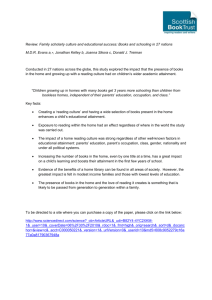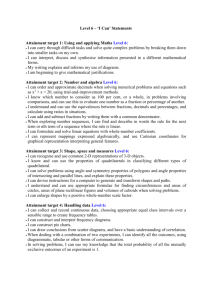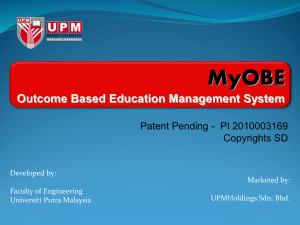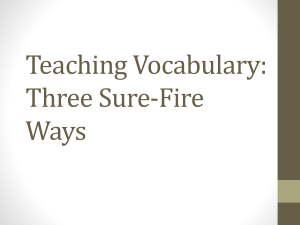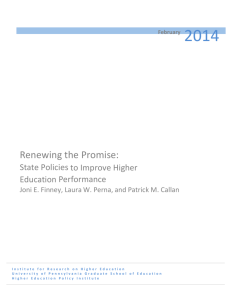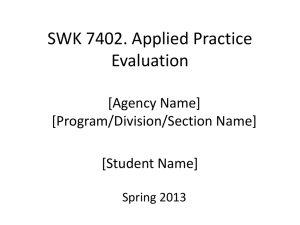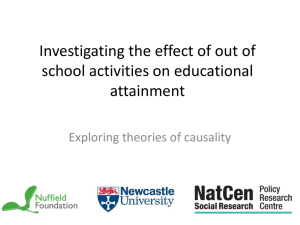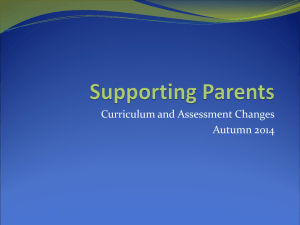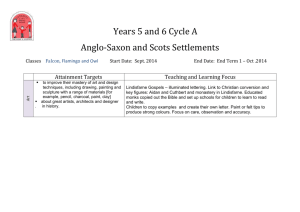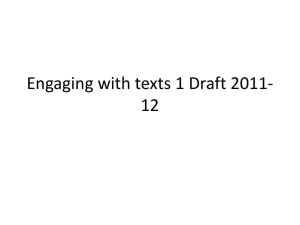Importance of Improving Educational Attainment
advertisement
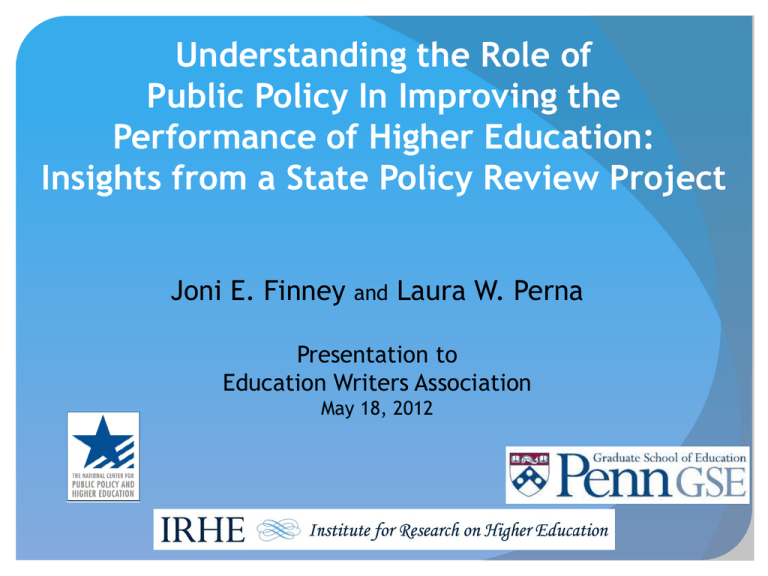
Understanding the Role of Public Policy In Improving the Performance of Higher Education: Insights from a State Policy Review Project Joni E. Finney and Laura W. Perna Presentation to Education Writers Association May 18, 2012 Acknowledgements Project team: Joni Finney, Laura Perna, Patrick Callan Michael Armijo, Jamey Rorison, Awilda Rodriguez Scott Stimpfel, Christopher Miller Sponsors: Institute for Research on Higher Education National Center for Public Policy & Higher Education Funding: Bill & Melinda Gates Foundation Lumina Foundation Importance of Improving Educational Attainment: International Competitiveness Source: Baum, S., Ma, J., & Payea, K. (2010). Education Pays. Washington, DC: College Board. Importance of Improving Educational Attainment: Growing Demand for College-Educated Workers Source: Carnevale, A., Smith, N., & Strohl, J. (2010). Help wanted. Washington, DC: Georgetown Center for Workforce and the Economy. Importance of Improving Educational Attainment: Equity and Social Justice Percent of Adults Age 25 and Older With At least a Bachelor's Degree 60% 50% 49.7% 40% 30.4% 30% 17.2% 20% 12.6% 10% 0% Asians Blacks Hispanics Source: Analyses of data from the American Community Survey. Whites Increasing Racial/Ethnic Diversity of The U.S. Population Source: WICHE (2008). Knocking on the college door. Boulder, CO: Author. -5% Massachusetts Connecticut New Hampshire Colorado North Dakota Minnesota New Jersey Maryland New York Vermont Virginia Hawaii Washington Rhode Island Illinois Kansas Nebraska Utah South Dakota Iowa California Oregon Wisconsin Pennsylvania US Montana Delaware North Carolina Maine Florida Alaska Georgia Wyoming Michigan Missouri Ohio Idaho South Carolina Arizona New Mexico Indiana Texas Alabama Oklahoma Tennessee Nevada Mississippi Kentucky Louisiana Arkansas West Virginia Educational Attainment Levels & Needs Vary Across States 55% % Adults with College Degrees (2008) Annual % Increase Needed to Meet 55% Goal by 2020 45% 35% 25% 15% 5% Source: Kelly (2010) What Do We Know about the Role of States in Promoting Educational Attainment? Measuring Up – Biennial state-by-state report card (National Center for Public Policy & Higher Education) • Identifies performance of each state on indicators of: Preparation Participation Completion Affordability Benefits • Does not reveal: • Reasons for high or low performance • Reasons for changes in performance Research Questions 1. What is the performance of higher education in particular states? How has performance changed over time? 2. What is the context that informs higher education performance in a state? How are aspects of context changing? How does the state context influence the policy options considered? 3. What policy levers have been used in each state? 4. What is the relationship between policy levers and higher education performance? Methods: Case Study Research 5 States • • • • • Georgia Illinois Washington Texas Maryland Data Sources • Quantitative data • Reports and documents • Interviews Data Analysis • Case study report for each state • Cross-case analysis Case Study Findings Illinois: A story of decline Washington: State leadership vacuum Maryland: Much accomplished, Much at stake Texas: Hard choices ahead Georgia: Perpetuating disparity www.gse.upenn.edu/irhe/srp Emerging Conclusions Across States Context: Demographic, political, cultural, historical, fiscal Structure and characteristics of higher education system Policy Statewide planning and leadership Strategic use of available fiscal resources Movement of students across educational levels and sectors Use of available higher education capacity Attention to cumulative contribution of policies to stratification of educational opportunity and attainment Is There a Shared Public Agenda for Higher Education in the State? Has the state established clear state-wide goals and priorities for higher education? Is there consensus among all stakeholders around the goals and priorities? Has the state implemented policies to achieve shared goals and priorities? Are there mechanisms to ensure accountability for achieving shared statewide goals and priorities? Are Fiscal Resources Used Strategically to Achieve Statewide Goals for Higher Education? Is there a mechanism for linking tuition to state appropriations and financial aid? Are increases in tuition linked to increases in family income? Are state resources used to reduce volatility in state appropriations and tuition? Does the state invest in need-based student aid? Is the state working to control costs & improve efficiency of higher education? Is the state using funding to encourage improved performance? How Does the State Ensure the Successful Movement of Students Across Education Levels and Sectors? Do state policies ensure that students who graduate from high school are academically prepared for higher education? Do state policies ensure that students can transfer between higher education institutions without loss of credit? How Is the State Using its Available Postsecondary Education Institutions to Meet Statewide Goals and Priorities? What mechanisms is the state using to ensure all state residents have higher education access? Strategies: branch campuses, university centers, transfer policies, applied baccalaureate degrees What mechanisms does the state use to encourage enrollment in particular sectors? How are for-profit colleges and universities considered in the state’s goals for higher education? What Is the Cumulative Contribution of Policies to Stratification of Educational Opportunity? Do K12 and higher education policies ensure college readiness? Do financing policies ensure college affordability? Are race and income explicit foci of state policies? How does the state address shortfalls in student aid? Do state policies “track” students into “workforce” and “education” programs? How do desegregation mandates impact enrollment and completion for different groups? Conclusions All states must do more to improve higher education performance Context and structure matter BUT lessons can be identified across states about the role of public policy in improving performance
